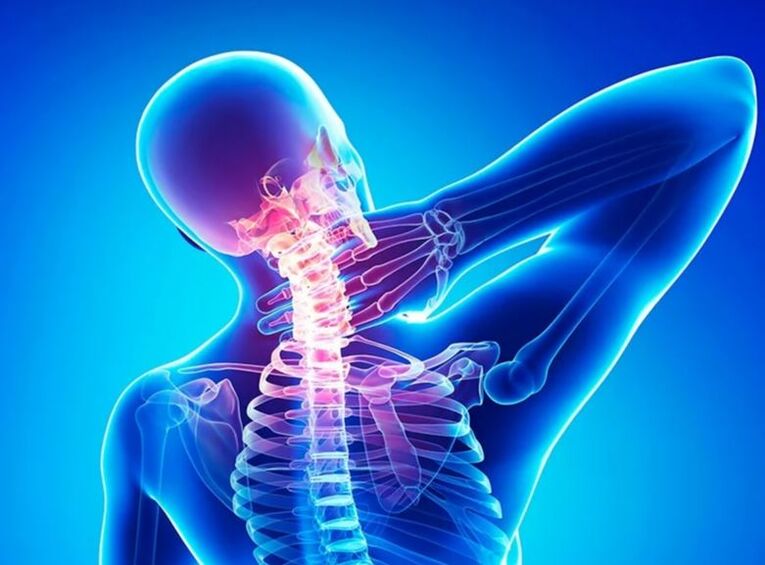
DISEASE DESCRIPTION
Osteochondrosis is a pathological state of bone stretch of the spine.The disease is characterized by dystrophic changes and a decrease in the absorbent function of intervertebral disc shock.Pathology causes deterioration of the spine column fixation capacity due to a decrease in intervertebral disc height, as well as a decrease in muscles and vertebral ligaments.
Various forms of osteochondrosis are distinguished, depending on the location of dystrophic changes: cervical, chest, lumbar, sacral.One of the most common is cervical osteochondrosis (up to 25% of the total).The disease follows unpleasant sensations that significantly reduce the quality of human life.
It is noteworthy that cervical osteochondrosis can occur at any age.At the moment, the disease is often diagnosed even in children and students, who is associated with a sedentary and long -term lifestyle on the computer and textbooks (subject to the wrong body position).
In the absence of treatment, osteochondrosis progresses, symptoms become more pronounced, usually complications occur: intervertebral hernies, nerve bites, circulatory, hypoxia etc.
Symptoms
With cervical osteochondrosis, insufficient nutrition of intervertebral discs of the cervical region occurs, from which they become brittle, and the distance between them decreases greatly.At the same time, bone tissue becomes prone to the growth and formation of bone (osteophyte) growth.In later stages, growths move and begin to squeeze nearby fabrics, vessels and nerves occurring in the cervical region.
Cervical osteochondrosis- Chronic disease and gradually developing.Therefore, the symptoms of pathology at different stages are different.
- 1st degree osteochondrosis symptoms
In the early stage of the disease, there is a slight decrease in the height of the intervertebral disc of the cervical spine.The pathology has light symptoms.There is discomfort in the neck, which can spread to the shoulders.In some cases, neck pain may appear, manifested in physical activity. - 2nd degree osteochondrosis symptoms
At this stage, the height of the disc continues to decrease, there is an incorrectly growing cartilage tissue, the protrusion develops.Cracks can form in the fibrous ring.The pain begins to intensify, becomes longer, can radiate in the hands and along the spine.There is a sense of stiffness with neck curves, a crisis and the appearance of headaches are possible. - 3rd degree osteochondrosis symptoms
In the third stage of the disease, a fibrous ring breaks and the formation of intervertebral hernias.The spine of the spine is deformed, displacements or subluxation of the vertebrae may occur.The patient feels acute and prolonged pain in the neck, numbness, partial loss of the sensitivity of skin areas in the neck, neck, shoulders or hands. - 4th degree osteochondrosis symptoms
At an advanced stage of the disease, irreversible changes occur - numerous osteophytes develop, intervertebral disc structures are gradually replaced by scar tissue.The resulting hernia presses blood vessels and nerves, a person has hypoxia of organs, pathologies of the circulatory system.The pain lasts a long time, the neck and the upper shoulder belt are immobilized, the quality of life is significantly worse.
Regardless of the severity of the disease, the patient may have symptoms such as headache, noise or touch ears, nausea, various visual deficiencies (sparkling, darkening, pain).
Reasons
Cervical osteochondrosis occurs due to incorrectly distributed load in the cervical spine.At the same time, the neck muscles cannot deal with mechanical pressure, spasm, which leads to circulatory disorders.From this, the degenerative changes come in the upper column.
Factors that contribute to the development of cervical spine osteochondrosis:
- Hereditary predisposition;
- neck injury;
- sedentary lifestyle;
- Long stay in a position - on the computer, driving, etc.;
- The presence of autoimmune diseases is rheumatoid arthritis, systemic lupus erythematosus,
- Scleroderma;
- Violation of metabolism;
- The presence of endocrine diseases - gout, diabetes;
- Excessive body weight.
Diagnosis
If it is suspected of the presence of cervical osteochondrosis, it is necessary to contact a timely medical institution.Comprehensive diagnosis will help identify the disease, evaluate its degree, and understand the causes of pathology development.A preliminary diagnosis is based on inspection and palpation - with osteochondrosis, the tension of the cervical muscles is observed;In some cases, the deformation of the spine is noticeable.
After the objective diagnosis, the doctor sends the patient to additional studies.
The following diagnostic methods are used to confirm the diagnosis:
- Magnetic resonance tomography;
- Radiography (lateral and straight);
- Multicamated computed tomography.
To determine the cause of pathology development, an ultrasound examination of nearby organs, heart ECG, duplex scanning of blood vessels, blood and urine tests can be prescribed additionally.
Therapeutic treatment
With the timely detection of cervical osteochondrosis, the disease is well lending itself to therapeutic treatment.Unfortunately, osteochondrosis cannot be completely healed, however, therapy will help to avoid additional development of the disease, alleviate unpleasant symptoms and normalize upper spine mobility.
The following methods are used for this:
- Drug treatment.Drugs relieve pain and inflammation, restore blood circulation and eliminate cramps in the neck muscles.For this, the following drug groups can be used: glucocosteroids, painkillers, slow action medicines, muscle relaxing, etc.
- Physiotherapeutic treatment.In addition to taking drugs to relax cervical muscles, eliminating cramps and normalizing blood circulation will help physiotherapeutic procedures: massage, acupuncture, laser effect, magnetotherapy, UHF therapy, phonophoresis etc.
- Therapeutic Gymnastics.Special exercise will help the patient strengthen muscle structure, align posture and improve blood supply to the top of the spine of the spine.
Surgical treatment
In the case of advanced stages of cervical spine osteochondrosis or with insufficient effectiveness of conservative methods, surgery is required.
The following methods of surgery can be used, depending on a specific clinical case:
- Small invasive removal of vertebral hernia.
- Laminectomy is an operation to remove vertebral processes.
- Removal of a hernia and stabilization of the operated segment using a system consisting of four titanium screws and two rod peaks.
- Endoscopic removal of a hernia.



















